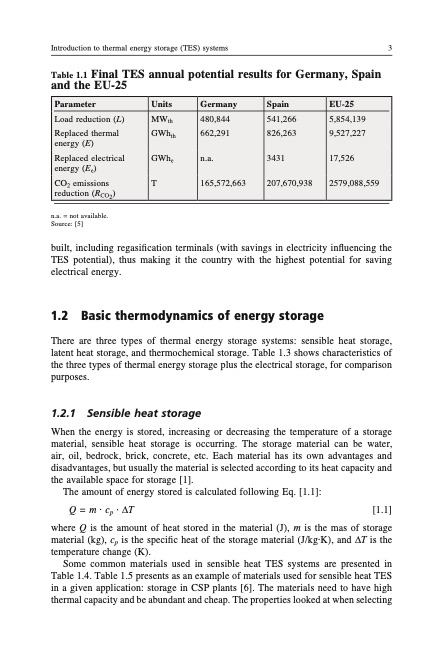
PDF Publication Title:
Text from PDF Page: 003
Introduction to thermal energy storage (TES) systems 3 Table 1.1 Final TES annual potential results for Germany, Spain and the EU-25 Parameter Units Germany Spain EU-25 Load reduction (L) MWth 480,844 541,266 5,854,139 Replaced thermal energy (E) GWhth 662,291 826,263 9,527,227 Replaced electrical energy (Ee) GWhe n.a. 3431 17,526 CO2 emissions reduction (RCO2) T 165,572,663 207,670,938 2579,088,559 n.a. = not available. Source: [5] built, including regasification terminals (with savings in electricity influencing the TES potential), thus making it the country with the highest potential for saving electrical energy. 1.2 Basic thermodynamics of energy storage There are three types of thermal energy storage systems: sensible heat storage, latent heat storage, and thermochemical storage. Table 1.3 shows characteristics of the three types of thermal energy storage plus the electrical storage, for comparison purposes. 1.2.1 Sensible heat storage When the energy is stored, increasing or decreasing the temperature of a storage material, sensible heat storage is occurring. The storage material can be water, air, oil, bedrock, brick, concrete, etc. Each material has its own advantages and disadvantages, but usually the material is selected according to its heat capacity and the available space for storage [1]. The amount of energy stored is calculated following Eq. [1.1]: Q=m·cp ·DT [1.1] where Q is the amount of heat stored in the material (J), m is the mas of storage material (kg), cp is the specific heat of the storage material (J/kg·K), and DT is the temperature change (K). Some common materials used in sensible heat TES systems are presented in Table 1.4. Table 1.5 presents as an example of materials used for sensible heat TES in a given application: storage in CSP plants [6]. The materials need to have high thermal capacity and be abundant and cheap. The properties looked at when selectingPDF Image | Introduction to thermal energy storage TES systems

PDF Search Title:
Introduction to thermal energy storage TES systemsOriginal File Name Searched:
TES-introduction.pdfDIY PDF Search: Google It | Yahoo | Bing
Turbine and System Plans CAD CAM: Special for this month, any plans are $10,000 for complete Cad/Cam blueprints. License is for one build. Try before you buy a production license. More Info
Waste Heat Power Technology: Organic Rankine Cycle uses waste heat to make electricity, shaft horsepower and cooling. More Info
All Turbine and System Products: Infinity Turbine ORD systems, turbine generator sets, build plans and more to use your waste heat from 30C to 100C. More Info
CO2 Phase Change Demonstrator: CO2 goes supercritical at 30 C. This is a experimental platform which you can use to demonstrate phase change with low heat. Includes integration area for small CO2 turbine, static generator, and more. This can also be used for a GTL Gas to Liquids experimental platform. More Info
Introducing the Infinity Turbine Products Infinity Turbine develops and builds systems for making power from waste heat. It also is working on innovative strategies for storing, making, and deploying energy. More Info
Need Strategy? Use our Consulting and analyst services Infinity Turbine LLC is pleased to announce its consulting and analyst services. We have worked in the renewable energy industry as a researcher, developing sales and markets, along with may inventions and innovations. More Info
Made in USA with Global Energy Millennial Web Engine These pages were made with the Global Energy Web PDF Engine using Filemaker (Claris) software.
Sand Battery Sand and Paraffin for TES Thermo Energy Storage More Info
| CONTACT TEL: 608-238-6001 Email: greg@infinityturbine.com | RSS | AMP |